← Back to Workshop Tactics
← Back to Storyteller Tactics


What is a Sailboat workshop?
This workshop tactic helps you find out what your goals really are, the reasons behind them and what’s stopping you from achieving them.
This exercise brings together teams and stakeholders to gain a shared understanding of their goals, drivers and barriers. You can find out what is slowing you down, or if the purpose or goals are not quite right.
This tactic requires you to Theme Sort as you go. Follow up this session by framing your barriers with How Might We… .
Sailboat Miro Template

How to run a Sailboat workshop
1. On a large surface, draw a boat out at sea - this boat represents the team or the project.
2. Next, draw an island - this represents the goal. Ask the group to write down what they believe the team or project’s goals are on sticky notes.
3. Ask each member to share what they’ve written as you Theme Sort them near the island.
4. If you haven’t already, draw a sail on the boat. Explain that this represents what’s driving you towards your goal. Ask the group to write down the drivers.
5. Share and Theme Sort them near the boat.
6. Draw an anchor coming from the boat. Explain this represents the barriers to the goal. Ask the group to write down what’s slowing or stopping you achieving the goals.
7. Share and Theme Sort them near the anchor.
8. Secret Vote the goals to get an understanding of what everyone believes is most important to work towards.
9. Finally, Secret Vote the barriers to understand what the most important problem to solve is.
Origin: Luke Hohmann
Not sure if this is the right approach for your team at the moment? Try a different goal-setting tactic . Or, when you are happy with the goal(s) you have set, move on to workshops designed to help you better understand the obstacles and challenges ahead.
You might like these Workshop Tactics
- Service Map
- Journey Map
- Empathy Map
Get Workshop Tactics®
Sailboat is one of 54 workshop recipe cards inside the Workshop Tactics card deck.
Confidently lead your product team and design better products, together.

Night Train
Create | Connect | Contribute
The Sailboat Exercise
An unconference approach to running productive team retreats.
I thoroughly enjoy planning and facilitating team retreats. When done well, they are a rejuvenating time for team members to reflect on the previous few months, to plan what’s coming next, and to just straight up have some fun together.
As a manager, I’ve found these retreats essential in keeping a team aligned and empowered to take ownership of what they’re building together. Even in Covid times – when the idea of getting together in-person seems quaint – taking time off from "normal work" to connect with your team in a less formal setting can still be quite valuable.
I’ve experimented with different approaches to running these retreats, but one exercise that has become essential is the “Sailboat Exercise”*:

At its core, the Sailboat Exercise is a brainstorming process for garnering honest feedback from employees about the state of the team / product / company. As such, it can be used independently of team retreats. That said, I’ve found it particularly effective in such a setting because it’s a fun, low pressure exercise at a time when folks are in a mindset to candidly assess the state of things — i.e. they’re removed from the stresses of their normal day jobs, and able to come up for air to think more holistically.
In fact, I’ve found it to be such a good exercise for divining the zeitgeist of the team — what’s been good/bad/indifferent and where should we head next? — that I use it to kick off the retreat, with its outcome driving the topics to be discussed during the rest of the event.
In this way, it essentially becomes a tool for running a team retreat as an unconference (i.e. a participant-driven conference), but with enough structure in place to achieve the goals of 1) clear-eyed retrospection, and 2) forward-thinking planning.
For those wanting to try out the Sailboat Exercise, the steps are as follows:
- Draw the sailboat scene on a whiteboard (have some fun with it!), being sure to include the following visual elements: the wind in the boat’s sails, the anchor dragging behind it, the hidden rocks beneath the surface ahead, and the island beyond that.
- Ask the team to write as many ideas as they can possibly think of, 1 per sticky note, for each of the four groups, where:
- Wind = the things that are propelling the team forward (e.g. inherent team strengths, competitive advantages of what you’re building, solid processes, etc.)
- Anchor = the things that are slowing the team down (e.g. gaps in the team, competitive weaknesses, subject areas to invest in, etc.)
- Rocks = the things that aren’t currently being considered at the moment, but are risk points for the team going forward (e.g. areas of tension, bottlenecks around scaling, lurking competition, etc.)
- Island = the things that the team should be aspiring to (e.g. short term objectives, medium term goals, long term mission, etc.)
3. Let the team members independently brainstorm these ideas for 20–30 minutes, encouraging them to not overthink it. At the end of the brainstorming process, have them affix each sticky note to the whiteboard near its appropriate visual element. People are often inclined to avoid affixing a sticky note that duplicates one already on the board, but it’s important to help the group fight that urge since it’s actually quite useful to see which topics were brought up by multiple team members.
4. At this point, the facilitator’s job becomes to organize the stickies on the board so that similar ones are physically connected (see image below). This can be done with the full group’s participation, or with just 1 or 2 others while the rest of the group mingles. Either way, it’s useful for the facilitator to have at least some help in order to group these sticky notes together into thematic topics.
5. Once grouped, the facilitator asks each team member to assign a total of 5 votes to whichever topics that they personally would like the group to discuss while at the retreat. I’ve found that five votes seems to be the right number for most situations, and that the fastest way to enable the voting is to let each person write their own tally marks:
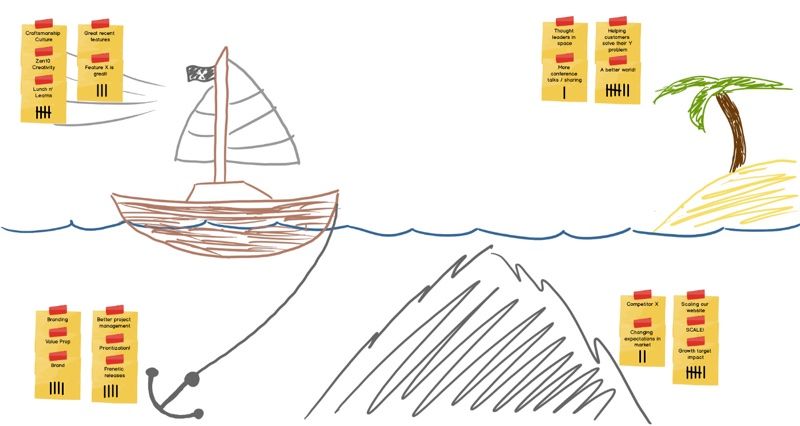
6. The most popular topics become the basis for the set of follow-up sessions during the rest of the retreat. The scheduling of which topics to discuss when can be outlined at this point, or left fluid as the retreat unfolds. As facilitator, your goal is to help the team cover as many of the highest ranked topics as possible while ensuring that the group is energized going into a given session at a particular time. If they don’t seem ready for a discussion because they need a break, some food, a lighter topic, etc. it’s best to delay or forgo the conversation rather than plow ahead.
7. Whenever possible, I look for others on the team to facilitate and/or drive the conversation during a particular session, only speaking up myself when necessary to move the discussion along, or to alleviate any buildup of tension.
8. At the end of our time together, we run a retrospective on the retreat as a whole — what did people like/dislike, and what might we do differently next time. This includes feedback on the Sailboat Exercise itself, as well as the topics that were brought up / discussed. As part of this retrospective, I make sure to thank everyone for their time, energy, and input. I also outline a few actionable steps we’ll be doing as we come out of the retreat because it’s important to a) ensure that team members have felt heard, and b) carry the positive momentum and energy from the event back into the workplace.
That’s it! The Sailboat Exercise has been a crucial tool in my manager tool belt largely because it’s simple to run and consistently produces great results.
I was recently asked by a fellow technologist what advice I had for creating a highly productive team. I said that, amidst a dizzying number of variables, the underlying foundation is almost always that each member of that team feels empowered — to share their opinions, to take on responsibilities, and to be a tangible part of contributing to something larger than themselves. It’s a cliched answer, of course, but as with most cliches, the devil is in the details; accomplishing this goal requires constant nurturing through thoughtful intent, communication, and processes.
In my experience, the Sailboat Exercise has been a great concrete tool for showing, not just telling, team members that they are central to the process of steering the ship.
* Note: I was introduced to this idea by friend and former colleague, Christopher Atkins . He had seen a few folks in the agile community using a version of it for sprint retrospectives, and we decided to experiment with the idea of leveraging it to run our next team retreat. It turned out to be a highly successful experiment, and I’ve since run the process numerous times / adapted it a bit as I’ve learned what works and what doesn’t. It’s worth noting that in doing research for this post, I discovered that the original inspiration for this type of process was a “Speed Boat Exercise” developed by Luke Hohmann .

The mosaic — how to build a healthy team
As many managers know, it’s damn hard to create and cultivate healthy teams.
Management Teams Visualizations Organizational Culture Leadership
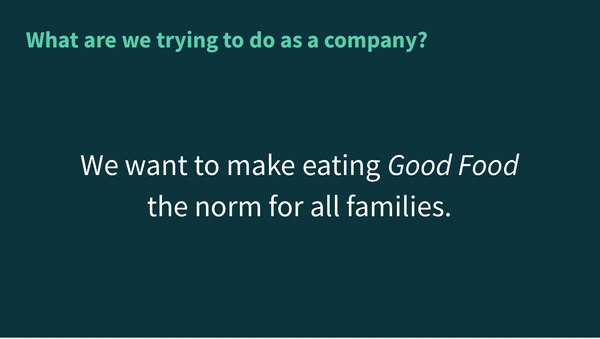
Strategy via storytelling
So many strategy artifacts. So little clarity.
Leadership Storytelling Strategy Organizational Culture Product Management
Sailboat Retrospective
You know the term ‘smooth sailing’? Imagine you could apply it to all of your current projects and future sprints. Using the Sailboat Retrospective technique can help you achieve team cohesiveness using a fun, visual exercise that gets all of your team members on the same page — or should we say— boat.

What exactly is a Sailboat Retrospective?
The Sailboat technique for retrospectives is a fun, interactive, and low-key way for your team to reflect on a project. It helps team members to identify what went right, what went wrong, and what improvements and changes can be made in the future. Usually the retrospective happens immediately after the completion of a project or sprint.
This technique uses the metaphor of a sailboat heading toward shore to help teams visualize their ship (team) reaching its ultimate destination (or ultimate goals).
Let’s look at a quick breakdown of the pieces involved:
Anatomy of the Sailboat Retrospective
In a Sailboat exercise, there are traditionally five main components:
- The sailboat: The team itself (or some teams prefer to make this the project)
- The island or shore: The ultimate goal or vision for the team (where it’s headed)
- The wind (or the sails): Things that are helping the team glide along (team strengths, competitive advantages of your product, good communication, etc.)
- The anchors: things that are slowing the team or project down or delaying progress (silos, areas of weakness, etc.)
- The rocks: the risks or potential pitfalls of a project (areas of tension, bottlenecks, competition, etc.)
Some Sailboat Retrospectives incorporate other aspects that fit into their vision such as the sun, which represents things that make the team feel happy or satisfied; or, choppy waves to represent something the team feels anxious about.
Some teams even scale their sails for bigger vs. smaller problems. If you have quite a few people involved in your retrospective or you have a lot of issues and need a way to prioritize, this is an option.
Feel free to get creative and add any aspects you feel would be beneficial to your retrospective. (This can be easily done via our Sailboat Retrospective template by adding additional columns. See below.)
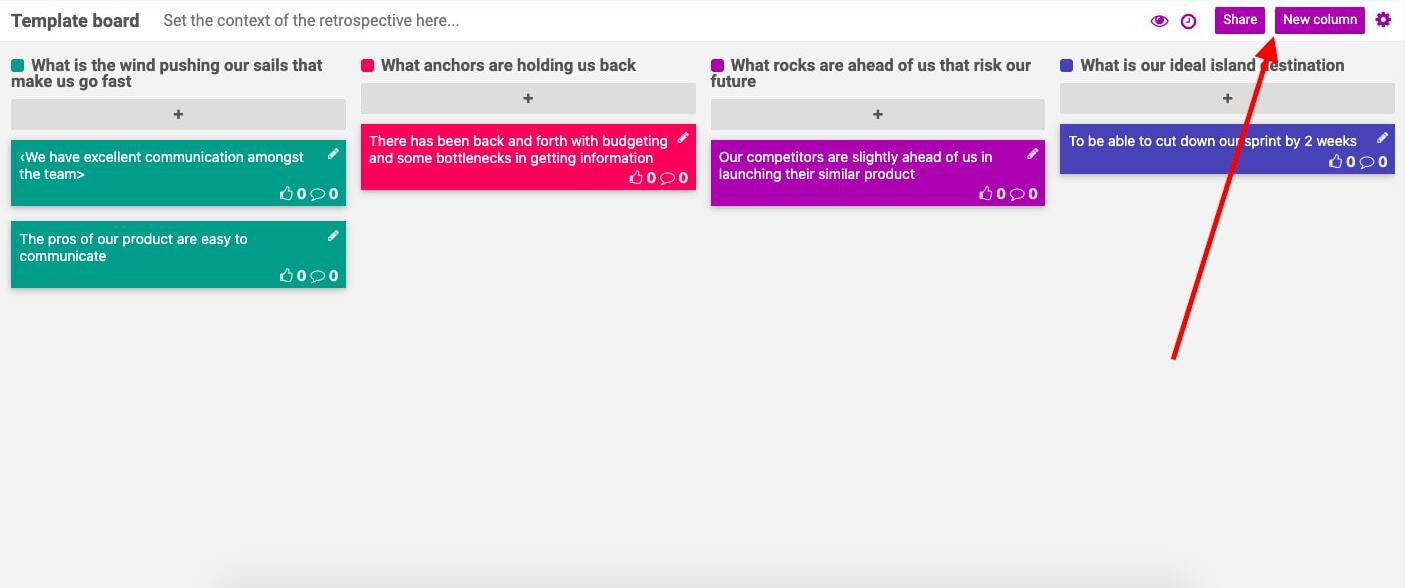
Why is the Sailboat Retrospective technique so effective?
The effectiveness of the Sailboat Exercise lies in its ability to use relatable metaphors to help team members easily identify important strengths and weaknesses. Because it is more of a non-pressure approach, it can help team members feel relaxed and more open to communicate without overthinking things.
This exercise is a fun way to get your team out of their day-to-day and think about the ‘big-picture’ to continually improve processes. It can also be a nice way of mixing up your retrospectives to keep them fresh and engaging.
And just because it’s fun doesn’t mean it’s not effective! The average Sailboat Retrospective normally helps to identify around 3-5 action items . That’s 3-5 new ways that your team can enhance their performance!

How to run one with your team
Ready to try your own Sailboat method retrospective?
Note: This exercise should take around 60 to 90 minutes to complete.
1. First, gather your key stakeholders
Usually, a retrospective includes the Scrum Master, Product Owner and members of the Scrum team. If there are other key stakeholders for your specific project invite them to the retrospective as well. This specific type of exercise really benefits from having different opinions and perspectives.
If your team is distributed or remote (as many are these days) you can still perform the Sailboat Exercise. Consider using a great online tool designed specifically to help distributed teams facilitate retrospectives.
2. Set some ground rules
It’s important to set the tone for how you envision your retrospective going. There are a few things that should never be included in any retrospective, and the Sailboat method is no exception. Keep your retrospective free of:
And make sure the focus is on:
- Having a growth mindset
- Being optimistic
- Being open-minded and open to constructive criticisms
- Being a psychologically-safe environment
3. Sketch your Visual
The rough sketch below is a pretty standard depiction for this type of retrospective. If you don’t want to draw your own, a simple Google search of sample Sailboat Retrospective images can help you find more examples.
Your visual should include all of the elements you’ll be discussing in order to help facilitate the exercise.
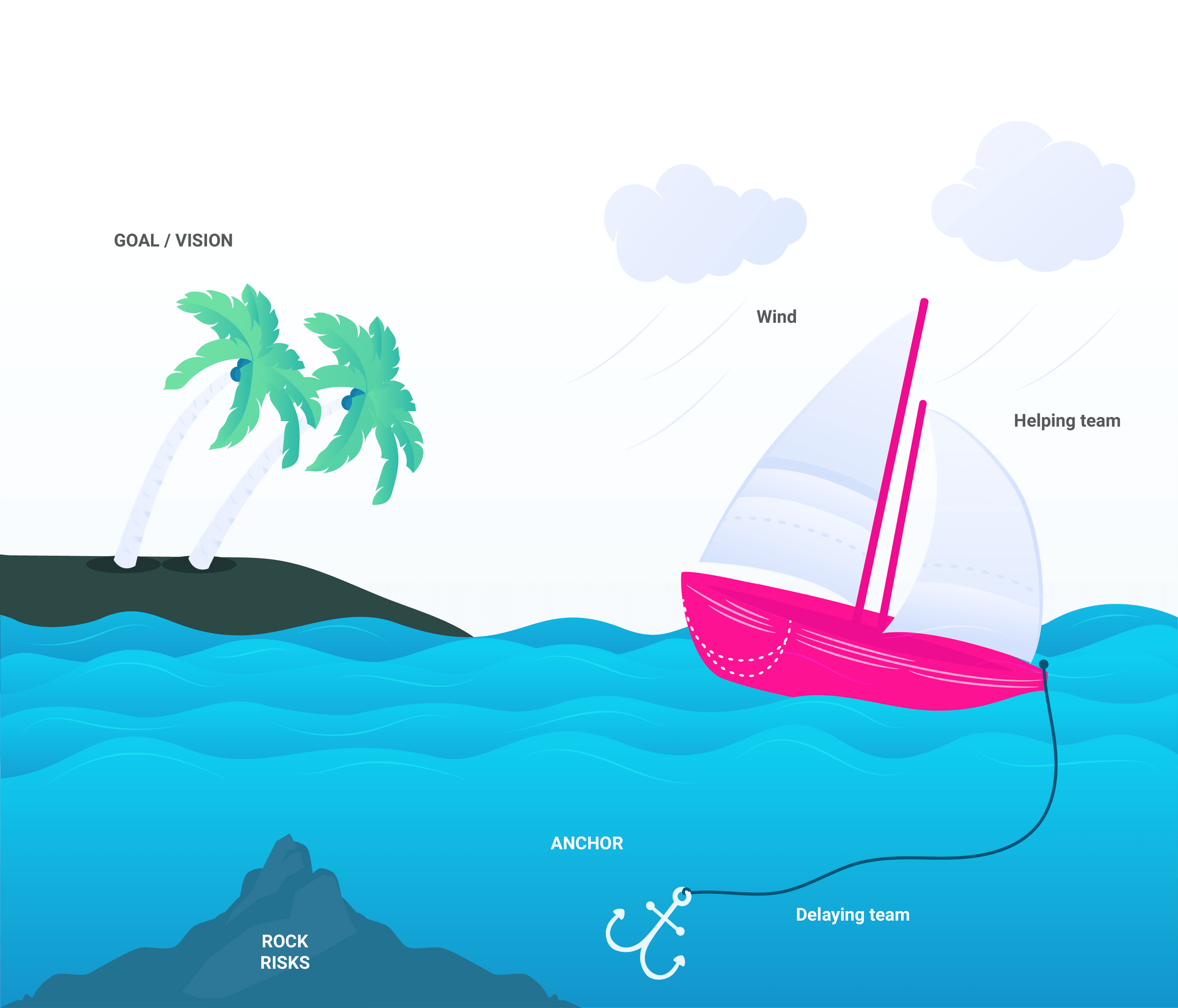
4. Set up your Template
Next, you’ll want to set up the template you’ll be using to capture your team’s thoughts. You can use a white board and post-its for this, but we’d suggest using an easy-to-build online template ( like this one ) to keep things organized.
Add all of the categories you will be discussing to your template. Then, take a few minutes to explain in detail what each category represents.
5. Brainstorming and/or discussion
Once your categories are all laid out on your template, you can either ask your team to quietly brainstorm for each one, or you can hold a group discussion. Really, this depends on the communication style of your team.
If you feel it might be better to have team members submit their feedback anonymously, they can write out their notations on post-its and you can gather them before discussion. Once you have everyone’s thoughts and additions, add them to your template.
This is the final phase of the retrospective. At this point, you and your team should identify what the biggest successes of your project were and what attributes you’d like to carry forward.
Discuss your anchors (obstacles) and brainstorm ways to overcome them. Also discuss ways to mitigate your potential risks (rocks) and how close or far you are from reaching your ultimate goals.
Once everyone is on the same page, conclude your retrospective and move forward with a plan and improved understanding of team performance!
That’s all there is to it! We hope your team enjoys this retrospective and gains some valuable insights along the way.
Happy sailing!
- Shop Card Decks
- Video Libary
Workshop Exercises: Discuss
A collection of workshop exercises that will help you ditch dull meetings and facilitate with confidence. It will help you master the design process and have more productive time with your team. The card deck will be ready for purchase in the end of 2025 and is now undergoing rigorous testing.
Instructions for running this play
- Set the scene . Invite your team and relevant stakeholders. Emphasize openness, constructive criticism, and growth mindset, while avoiding blame and negativity.
- The sun – good things that can come out of this
- Wind (or sails) – what drives them forward?
- An anchor – things that can slow the team down or bring them to a halt
- Rocks, icebergs, cliffs, or pirates – risks or potential pitfalls along the way
- A treasure – potential unexpected wins Consider whether you need all of the symbols. The sailboat and island are mandatory.
- Identify Goals, Drivers, and Obstacles. In a 5-10 minute Silent Storming exercise, ask participants to write input on each of the symbols you decided to include in the drawing and have them Playback their sticky notes while putting them on a shared board.
- Group and Categorize . Choose one or more participants to group similar sticky notes together. Discuss fairness of the groupings in the group and adjust as necessary.
- Prioritize and Plan next steps. Vote on key areas to focus on. Discuss how to amplify the winds, cut the anchors, and avoid the rocks. Plan how to celebrate the sun and strive towards the goals. Conclude with an agreed action plan.
Tips to perfect this play
Master and adapt the play to fit your context and needs.
Tip: Adapt to your own context
Consider adapting the sailboat metaphor to your team's particular context or interests. How about a spaceship, submarine, or a skateboard?
Tip: Change the symbols
Other symbols could include "currents" for external factors or "weather conditions" to symbolize the overall team morale
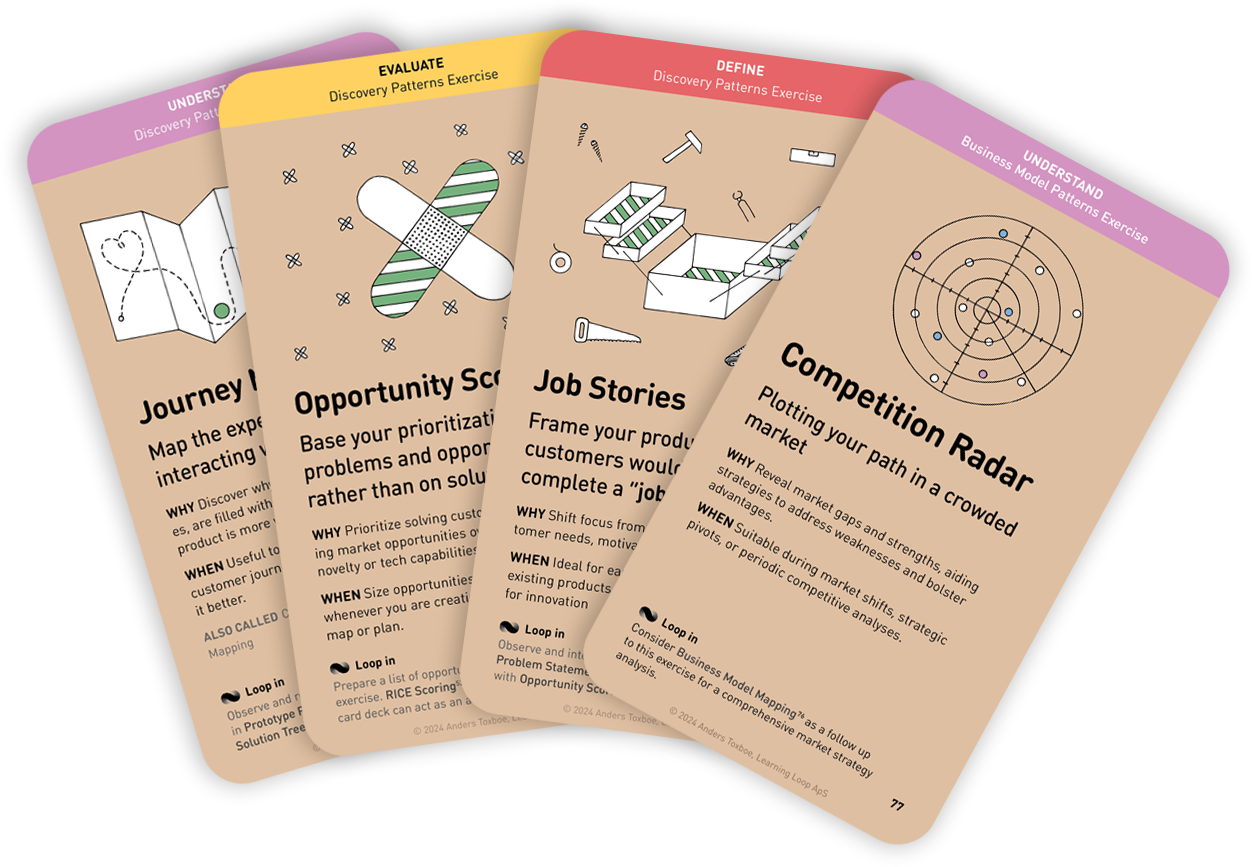
This workshop exercise is part of the Workshop Patterns printed card deck .
Related plays.
- Fishbone Diagram
- Force Field Analysis
- Future Press Release
- Sailboat Retrospective Template & Example for Teams by Miro
- 5 fun sprint retrospective ideas with templates by Katrina Morales
Want to learn more?
Receive a hand picked list of the best reads on building products that matter every week. Curated by Anders Toxboe. Published every Tuesday.
No spam! Unsubscribe with a single click at any time.
Validation Patterns
Validate the problem.
Is your problem worth solving?
- Closed-Ended Surveys
- Cold Calling
- Comprehension Test
- Contextual Inquiry
- Crowdfunding
- Crowdsourcing
- Customer Service Logs
- Fake door testing
- Family Tree
- Find the Watering Hole
- Five People Who Are In
- Five Second Test
- Focus Group
- Industry Forums
- Move in With the Customer
- Read App Reviews
- Remote User Testing
- Sell the Future
- Write Down Your Concept
Validate the market
Don't build something that nobody wants
- Classified Posting
- Collect Pre-orders
- Conjoint Analysis
- Data Mining
- Feature Stub
- High Hurdle
- Offer a Sample
- One Night Stand
- Physical Before Digital
- Product-Market Fit Survey
- Run Test Ads
- Sales Pitch
- Single-Feature Product
- Spoof Landing Pages
- Trends and Keyword Analysis
- Wizard of Oz
Validate the product
Does your product solve the problem?
- A/B Testing
- Beta Launch
- Clickable Prototype
- First Click Testing
- Guerilla User Testing
- Impersonator
- LEGO prototype
- Micro Surveys
- Minimum Marketable Product
- Multivariate Testing
- Net Promoter Score (NPS)
- Paper Prototype
- Pretend to Own
- Takeaway Test
- Try it Yourself
- Working Prototype
Validate willingness to pay
Are people willing to reach into their wallets?
Business Model Patterns
Customer segment.
Meeting the unique needs of each and every customer
- Bottom of the Pyramid
- Customer Loyalty Program
- Ultimate Luxury
Pricing Model
Innovative pricing strategies for sustainable growth
- Access over Ownership
- Bait and Hook
- Cash Machine
- Dynamic Pricing
- Pay What You Want
- Reversed Bait and Hook
Revenue Streams
Explore different revenue streams to maximize potential
- Fractional Ownership
- Franchising
- Hidden Revenue
- Microfinance
- Pay Per Use
- Performance-Based Contracting
- Subscription
- Virtual Economy
- Rent Instead of Buy
Value Network
Sharing resources and risks for mutual benefit in the network
- Affiliation
- Brands Consortium
- Joint Venture
- Layer Player
- Multi-Sided Market
- No Middle Man
- Omnichannel
- Orchestrator
- Peer-to-Peer
- Platform as a Service
- Revenue Sharing
- Self-Service
- Shop in Shop
- Virtualization
Value Proposition
Value proposition strategies for long-term success
- Blended Value
- Cross Selling
- Experience Selling
- Guaranteed Availability
- Ingredient Branding
- Make More of It
- Mass Customization
- One-stop-Shop
- Product as Point of Sale
- Product Self-Service
- Reverse Innovation
- Sensor as a Service
- Solution Provider
- White Label
Value Proposition Development
Unlocking growth through value proposition design
- Digitization
- From Push to Pull
- Leverage Customer Data
- Open Business Model
- Open Source
- Reverse Engineering
- Trash-to-Cash
- User Designed
Workshop Patterns
Convert empathy to clarity by refining insights into problem definitions
- Dependency Mapping
- Future-Back Planning
- Objectives and Key Results
Uncover insights and drive problem-solving through deep analysis
- Assumptions Collection
- Business Model Mapping
- Circles of Influence
- Empathy Mapping
- Force Field Network
- Hopes and Fears
- Impact Mapping
- Journey Mapping
- Market of Skills
- Opportunity Solution Tree Mapping
- Prototype Persona
- Service Blueprint
- Thinking Hats
- Skills Star Mapping
- Stakeholder Mapping
- Starbursting
- Touchpoint Mapping
- User Story Mapping
- Value Proposition Mapping
- Why-How Laddering
- Adjacency Matrix
- 20-Year Brand Roadmap
- Competitive Landscape
- Design Principles
- Golden Circle
- Golden Path
- Hypothesis Statement
- Job Stories
- Personality Sliders
- Problem Statement
- Product Box
- Storyboarding
- Top Audiences
- Top Brand Values
- Value Proposition Statement
Unleash creativity to collaboratively discover fresh solutions
- 3-12-3 Brainstorm
- Bad Idea Brainstorming
- Competitor Demos
- Crazy Eights
- Design Charrette
- Figure Storming
- Forced Analogy
- How Might We
- Mind Mapping
- Perfection Game
- Powers of Ten
- Reverse Brainstorming
- Round Robin
- The Anti-Problem
- Yes, And! Brainstorm
- Head / Heart / Hand
- PEST Analysis
- Rose / Thorn / Bud
- Start / Stop / Continue
- SWOT Analysis
Prioritize ideas or challenges to determine where to direct your attention and efforts
- Assumptions Mapping
- Blind Voting
- Decider Vote
- Fist to Five
- Five-Fingered Consensus
- Heatmap Voting
- Letter to Myself
- Note and Vote
- Priority Mapping
- Project Plan
- Prune the Product Tree
- RACI Matrix Mapping
- Red:Green Cards
- Roles and Responsibilities
- Roman Voting
- Stack Ranking
- Trade-off Sliders
- Who / What / When Matrix
Build a shared understanding to reach your goals together
- Fishbowl Discussion
- Lean Coffee
- Mad / Sad / Glad
- Plus / Delta
- Three Little Pigs
Core techniques used to plan and lead effective workshops
- Affinity Mapping
- Card Sorting
- Parking Lot
- Poster Session
- Return on Time Invested
- Safety Check
- Silent Storming
- Talking stick
Ice Breakers
Relieve initial group awkwardness and establish a safe space
- Personal Histories
Persuasive Patterns
Encourage action by eliciting positive or negative emotions about the behavior or situation.
- Anchoring Bias
- Authority Bias
- Cashless Effect
- Commitment & Consistency
- Curiosity Effect
- Endowment Effect
- Halo Effect
- Humor Effect
- Intentional Gaps
- Isolation Effect
- Need for Closure
- Optimism Bias
- Peak-End Rule
- Priming Effect
- Reciprocity
- Retaliation
- Scarcity Bias
- Serial Positioning Effect
- Status-Quo Bias
- Value Attribution
Restructure
Alter physical or social environments to subtly shift behavior patterns.
- Decoy Effect
- Default Effect
- Framing Effect
- Hedonic Adaptation
- Loss Aversion
- Risk Aversion
Broaden knowledge or insight regarding the behavior or situation to inform decisions.
- Analysis Paralysis
- Cognitive Dissonance
- Conceptual Metaphor
- Delay Discounting
- Inaction Inertia Effect
Demonstrate
Show practical examples or models of the desired behavior for clear guidance.
- Recognition over Recall
- Role Playing
- Storytelling
Connect the behavior to individual values and concerns, making it personally relevant.
- IKEA Effect
- Liking Bias
- Negativity Bias
- Noble Edge Effect
- Nostalgia Effect
- Positive Mimicry
- Self-Expression
- Social Proof
Highlight current actions and their reasons, bringing unconscious habits to awareness.
- Centre-Stage Effect
- Periodic Events
- Picture Superiority Effect
Streamline the process or action, making it more accessible and less daunting.
- Appropriate Challenges
- Autonomy Bias
- Choice Closure
- Commitment Devices
- Endowed Progress Effect
- Feedback Loops
- Fresh Start Effect
- Limited Choice
- Pattern Recognition
- Present Bias
- Zeigarnik Effect
Develop necessary skills and competencies to enable effective action.
- Competition
- Unlock Features
Increase the expectation of costs or consequences of action.
- Sunk Cost Bias
Use the promise of rewards to motivate and encourage desired actions or behaviors.
- Achievements
- Goal-Gradient Effect
- Prolonged Play
- Temptation Bundling
Community events Product Loop
Product Loop provides an opportunity for Product professionals and their peers to exchange ideas and experiences about Product Design, Development and Management, Business Modelling, Metrics, User Experience and all the other things that get us excited.
- Become a mentee
- Become a mentor
- Product Management glossary
- User Experience glossary
- Product playbooks
- Product & UX video library
- Privacy Policy
- Terms and Conditions
- Code of Ethics
Made with in Copenhagen, Denmark
Want to learn more about about good product development, then browse our product playbooks .
Download your Free Persuasive Pattern samples
Sign up to our newsletter to download a free copy of our top rated cards in the Persuasive Pattern card deck. Link to download sent via e-mail.

Confirm your e-mail & start downloading
Thank you for your interest in our card deck. We've emailed you a newsletter confirmation link. Click it and we will send you another email with a download link.

- Work With Us
- Project To Product
Run The SailBoat Agile Exercise or Sailboat Retrospective
by Luis Gonçalves on Jun 16, 2024 9:04:15 AM
In this post, I will explain the method known as SailBoat Exercise or Sailboat Retrospective.
This exercise can be found in the book Getting Value out of Agile Retrospectives . A book that I and Ben Linders wrote with a foreword by Esther Derby .
Sailboat Exercise
What you can expect to get out of this technique.
From my experience, this technique is quite appreciated by teams because of its simplicity.
This exercise helps teams to define a vision of where they want to go; it helps them to identify risks during their path and allows them to identify what slows them down and what helps them to achieve their objectives.
When you would use this technique
I believe this method is quite simple and does not require any special occasion. Although, it might be interesting for situations when a retrospective is conducted with more than one team at the same time.
I had a situation, not long time ago that two teams worked together and because of their level of dependency on each other, they decided to conduct a common retrospective because of some ongoing issues.
Using the SailBoat exercise can be extremely interesting because we simply put the name of both teams on the SailBoat and we remind everyone that we are on the same SailBoat navigating in the same direction.
This technique reveals all the good things and less positive things performed by a team.
How to do it
This retrospective is quite simple. First, we draw a SailBoat, rocks, clouds, and a couple of islands like it is shown in the picture on a flip chart.
The islands represent the teams´ goals/vision. They work every day to achieve these islands. The rocks represent the risks they might encounter in their vision.
The anchor on the SailBoat is everything that is slowing them down on their journey. The clouds and the wind represent everything that is helping them to reach their goal.
Having the picture on the wall, write what the team vision is or what our goals are as a team. After that, start a brainstorming session with the team allowing them to dump their ideas within different areas.
Give them ten minutes to write their ideas. Afterward, give 5 minutes to each person to read out loud their ideas.
At this point discuss together with the team how can they continue to practice what was written on the "clouds" area. These are good ideas that help the team, and they need to continue with these ideas.
Then spend some time discussing how can the team mitigate the risks that were identified. Finally, together with the team chose the most important issue that is slowing the team down.
If you do not find an agreement within the team about the most important topic that should be tackled, you can use the vote dots.
In the end, you can define what steps can be done to fix the problem, and you can close the retrospective.
Like many other exercises, this exercise does not require a collocation of a team. You can use, for example, tools like Lino, to apply the exercise to non-collocated teams. This tool allows us to do everything that we need to run this exercise.
What do you think? Your feedback is always extremely important for me, so please leave me your comments.
An Agile Retrospective is an event that ́s held at the end of each iteration in Agile Development and it serves for the team to reflect on how to become more effective, so they can tune and adjusts its behavior accordingly.
I believe the SailBoat exercise is quite a simple Agile Retrospective Exercise and does not require any special occasion.
If you are interested in getting some extra Agile Retrospectives exercises, I created a blog post with dozens of Agile Retrospectives Ideas , check them and see if you find something interesting.
Did you like this article?
We enable leaders to become highly valued and recognized to make an impact on the World by helping them to design Digital Product Companies that will thrive and nourish in the Digital Age, we do this by applying our own ADAPT Methodology® .

- Agile Methodologies (18)
- Product Strategy (18)
- Product Mindset (14)
- Project To Product (10)
- Agile Retrospectives (9)
- Knowledge Sharing (9)
- Time To Market (8)
- Product Discovery (7)
- Continuous Improvement (5)
- Strategy (5)
- Scrum Master (4)
- Content Marketing Strategy (3)
- Product Owner (3)
- Technical Excellency (3)
- Digital Transformation (2)
- Innovation (2)
- Scaling (2)
- Team Building (2)
- Business Model (1)
- Cost Of Delay (1)
- Customer Feedback (1)
- Customer Journey (1)
- Customer Personas (1)
- Design Thinking (1)
- Digital Leadership (1)
- Digital Product Tools (1)
- Go To Market Strategy (1)
- Google Design Sprint (1)
- Lean Budgeting (1)
- Lean Change Management (1)
- Market Solution Fit (1)
- Organisational Impediments (1)
- Outsourcing (1)
- Product (1)
- Product Metrics (1)
- Product Roadmaps (1)
- September 2024 (1)
- August 2024 (1)
- July 2024 (2)
- June 2024 (22)
- May 2024 (8)
- April 2024 (11)
- February 2024 (2)
- January 2024 (152)
- April 2023 (1)
- February 2023 (1)
- July 2021 (1)
- January 2017 (1)

Organisational Mastery
Get your free copy

Product First

The Sailboat Retrospective is a fun and creative way for teams to reflect on the sprint and identify areas for improvement. It’s called “Sailboat” because the metaphor of a sailboat helps the team visualize their journey, the obstacles they faced, and the direction they want to sail towards in the future. The Sailboat or Speedboat Method for Sprint Retrospectives is an easy way to: adopt, reflect and map the team’s way forward easily, in a fun, tactile and visual way. It helps the team to reflect on what’s going well and what could be better, analyze their sails and anchors and identify opportunities for improvement or change.
The idea is that the team is on a sailboat, heading towards their goal while dealing with winds and icebergs along the way. Winds help propel the boat forward but obstacles such as pirates, rocks, and stubborn anchors represent the risks that the team might encounter that could slow them down or even stop them from getting to where they need to be.
- Boat : The Scrum team
- Sails : The things that helped us move forward (Wind, Cloud)
- Anchors : The things that held us back (Pirates, Rocks, Sharks, Icebergs, and Anchors)
- Island : The goals to be achieved
- Sun : What the team liked, the actions or attitudes that deserve thanks
- Reef : Represent future obstacles that have been identified, which the group is likely to encounter in the subsequent iterations.
Note : The original Sailboat technique doesn’t have a Sun – I added it to give them a feeling of accomplishment as most teams should understand that there are already things that work just fine. And it’s definitely worth the time to help the team to build on this base.
- Fact-based Analysis for Sprint Retrospective
- Start, Stop, and Continue Sprint Retrospective
- Glad-Sad-Mad Sprint Retrospective
- Starfish Sprint Retrospective
- Sailboat Sprint Retrospective
- Liked Learned Lacked Longed For (4Ls) Retrospective
Different Steps of Sailboat Sprint Retrospective
Step 1: set the stage – draw a sailboat.
Start by setting clear expectations for the meeting, including the purpose, goals, and agenda. Make sure everyone is aware of the retrospective’s purpose and that it is a safe space for open and honest communication.
Let the team draw a picture of a sailboat floating in the water, and fill half the space above and half below the water with the sun, anchors, wind, rocks, reef, and an island or you can simply print pictures and just attach them to the board or any available wall space. This visual representation can help the team better understand their progress.
Note : Team drawing the boat helps to act as an icebreaker and get the group participating and on the boat.
Step 2: Name the Sailboat
Decide the topic/theme of the retrospective and name the boat accordingly.
Step 3: Add mission
Ask the team to write what their mission is, what they want to achieve, and what their goal is, and add these post-it notes to the hull of the boat. The team can amend or clarify or replace as the game continues.
The boat can be saved and revisited as part of sprint reviews, where sails and anchors can be reviewed, rescored, removed, and new sails and anchors added.
Tips : Ask team members to share their successes and challenges during the sprint or project. This allows everyone to see what worked well and what didn’t, which can help identify areas for improvement.

Step 4: Add Sails and Anchors
Ask the team to add sails and anchors to their boat. Sails represent things going well, what’s good, and what is putting the wind into their sails. Anchors are the things that could be going better, the anchors holding them back and limiting progress.
Step 5: Scale your sails and anchors
Ask the teams to scale their sales and anchors, their sails from +1 to + 10, is it a +1 or 2, a nice but relatively small in-value sail, or a main sail that’s providing huge momentum, a +9 or +10? The anchors from -1, a minor impediment, or -10 this anchor have stopped us from moving forward at all.
Now team should brainstorm and discuss each note, seek to clarify the meaning of the note, and then decide as a group where on the scale it should be. Teams can vote by Dot Voting. The team can compare Sails and Anchors. Is it a bigger or smaller sail/anchor than the previous one? The key here is engaging in group discussions, awareness, and consensus on what the sail/anchor is and how it impacts the team. Sticky notes may need to be clarified with extra information or split into multiple notes to score separately.
Step 6: Add ideas for +1 raising sails and/or anchors
Once all sails and anchors have been discussed and scored ask the team to capture activities and improvements to help raise sails further and raise up anchors. Ask the team to think of small actions that would raise one of the sails, or anchors on the boat by just one point, raise an anchor from a -6 to a -5, or raise a sail from a 2 to a 3. Capture ideas for improvements on post-it notes and place them beside the relevant anchor or sail.
Step 7: Discuss Reef, and Sun and Plan the next steps
Remember to celebrate success and plan action items for current as well as future obstacles that have been identified during the above brainstorming.
If there are numerous suggestions for raising sails and anchors then team activities like estimation games, MoSCoW prioritization, and Dot Voting to help discuss, rank, and decide upon which improvements to take forward. Map the improvements/actions into the team backlog/future work or on a dedicated change and improvement board to help track and measure progress.
Sailboat Retrospective Example
Let’s take an example of a team that developed a mobile app during the sprint. The team was able to deliver the features on time but faced some challenges during the sprint. Here’s how they conducted the Sailboat Retrospective:
- Draw a Sailboat: The team drew a sailboat with a sail, a mast, a keel, a waterline, wind, rocks, and a shore.
- Write the Sprint Goal: The team wrote the sprint goal at the top of the sailboat: “Develop a mobile app with login, registration, and dashboard features.”
- List the Positive Factors: The team listed the positive factors that helped them during the sprint, such as good communication, pair programming, and code reviews. They wrote these on the sail and the mast, as the wind filled the sail and propelled the sailboat forward.
- List the Negative Factors: The team listed the negative factors that hindered their progress during the sprint, such as a lack of automated testing, dependency on external APIs, and unclear requirements. They wrote these on the keel and the rocks, as the obstacles that slowed down the sailboat or could cause it to crash.
- Identify the Improvement Areas: The team discussed the negative factors and identified areas for improvement.
Open-ended Questions for Sailboat Retrospective
- What makes them happy?
- What’s slowing them down?
- What’s propelling them forward? What are the gusts of wind that help our sailboat to move forward?
- Is this bigger or smaller than the last item we scaled?
- If you could cut away one anchor which would it be? How could you do that?
- If you could raise one sail to 10 which would it be? How could you do that?
- What would happen if all anchors were cut away? what would change?
- If you could add an ‘iron sail’ (an engine!) to your sailboat what would it be?
- How can we raise this sail from a 5 to a 6?
- How can we raise this anchor from a -7 to a -6?
Sailboat or Speedboat Facilitation Tips
- First collect all the anchors, as it’s easier for most teams to organize their current problems.
- Ask the team to turn each anchor into goals, desires, or wishes and put them before the cloud to represent the gusts of wind pushing the boat forward.
- Use these “winds” to define a desirable goal you will use as a true north for the rest of the retrospective.
- Use data to help guide the retrospective discussion, such as team velocity or user feedback. Data can help provide a more objective view of the team’s performance.
- Based on the discussion, identify specific action items that the team can work on to improve. Make sure to assign ownership of these items and set clear deadlines.
- Follow up on the action items from the retrospective in the next meeting to ensure progress is being made.
- Keep the retrospective focused on finding solutions, not blaming individuals or criticizing past decisions. Maintain a positive and constructive atmosphere to encourage open communication and a sense of teamwork.
Sailboat or Speedboat Challenges & Strategies to Overcome
Sailboat Sprint Retrospectives are an important part of the Agile development process, as they allow teams to reflect on their progress and identify areas for improvement. However, there are several common challenges that teams may face during these retrospectives. Here are some of the most common challenges and tips on how to overcome them:
- Lack of Participation: In some cases, team members may be hesitant to speak up during a retrospective, which can hinder the effectiveness of the session. To overcome this, the facilitator can encourage participation by creating a safe and open environment where all team members feel comfortable sharing their thoughts and ideas. They can also try using interactive activities or icebreakers to get everyone engaged.
- Blaming and Finger-Pointing: Retrospectives can sometimes turn into a blame game, with team members pointing fingers at each other for mistakes or issues. This can lead to a negative atmosphere and prevent constructive feedback. To avoid this, the facilitator should set ground rules at the session’s beginning that encourage constructive criticism and discourage personal attacks.
- Lack of Actionable Insights: In some cases, retrospectives can feel like a waste of time if the team does not develop actionable insights they can implement in future sprints. To prevent this, the facilitator can ensure that the team focuses on identifying specific actions that they can take to improve in the next sprint. They can also assign action items to team members and set deadlines for completion.
- Dominant Voices: Sometimes, one or two team members may dominate the conversation during a retrospective, preventing others from sharing their thoughts and ideas. To prevent this, the facilitator can use round-robin or anonymous feedback to ensure that everyone has an equal opportunity to speak.
- Lack of Follow-Through: Even if the team comes up with actionable insights during the retrospective, there is a risk that they may not be implemented in future sprints. To prevent this, the facilitator can assign ownership of action items to specific team members and follow up on their progress in subsequent retrospectives.
Scrum Master Role in Facilitating Sailboat Sprint Retrospective
The Scrum Master plays a critical role in facilitating a successful Sailboat Sprint Retrospective. Here are some key responsibilities of the Scrum Master in this process:
- Creating a Safe and Open Environment: The Scrum Master needs to create a safe and open environment where team members feel comfortable sharing their thoughts and feedback. The Scrum Master should encourage open and honest communication, actively listen to the team members, and ensure that everyone has an opportunity to share their perspectives.
- Guiding the Retrospective Process: The Scrum Master should guide the retrospective process, ensuring that it stays on track and that the team is making progress towards actionable improvements. The Scrum Master should use the Sailboat metaphor to help the team identify areas of strength and improvement, and facilitate a discussion that leads to actionable items.
- Encouraging Collaborative Problem Solving: The Scrum Master should encourage the team to work collaboratively to solve problems and address issues identified during the retrospective. The Scrum Master should facilitate a discussion where the team can brainstorm potential solutions and identify concrete action items.
- Facilitating Continuous Improvement: The Scrum Master should ensure that the team is focused on continuous improvement and that the actionable items identified during the retrospective are implemented. The Scrum Master should work with the team to develop a plan to implement the changes and monitor progress towards the goals identified.
- Monitoring Team Dynamics: The Scrum Master should also monitor team dynamics during the retrospective to identify any issues that may be hindering team performance. The Scrum Master should work with the team to address these issues and promote a positive team culture.
Sprint Retrospective – Tools and Techniques: Click Here
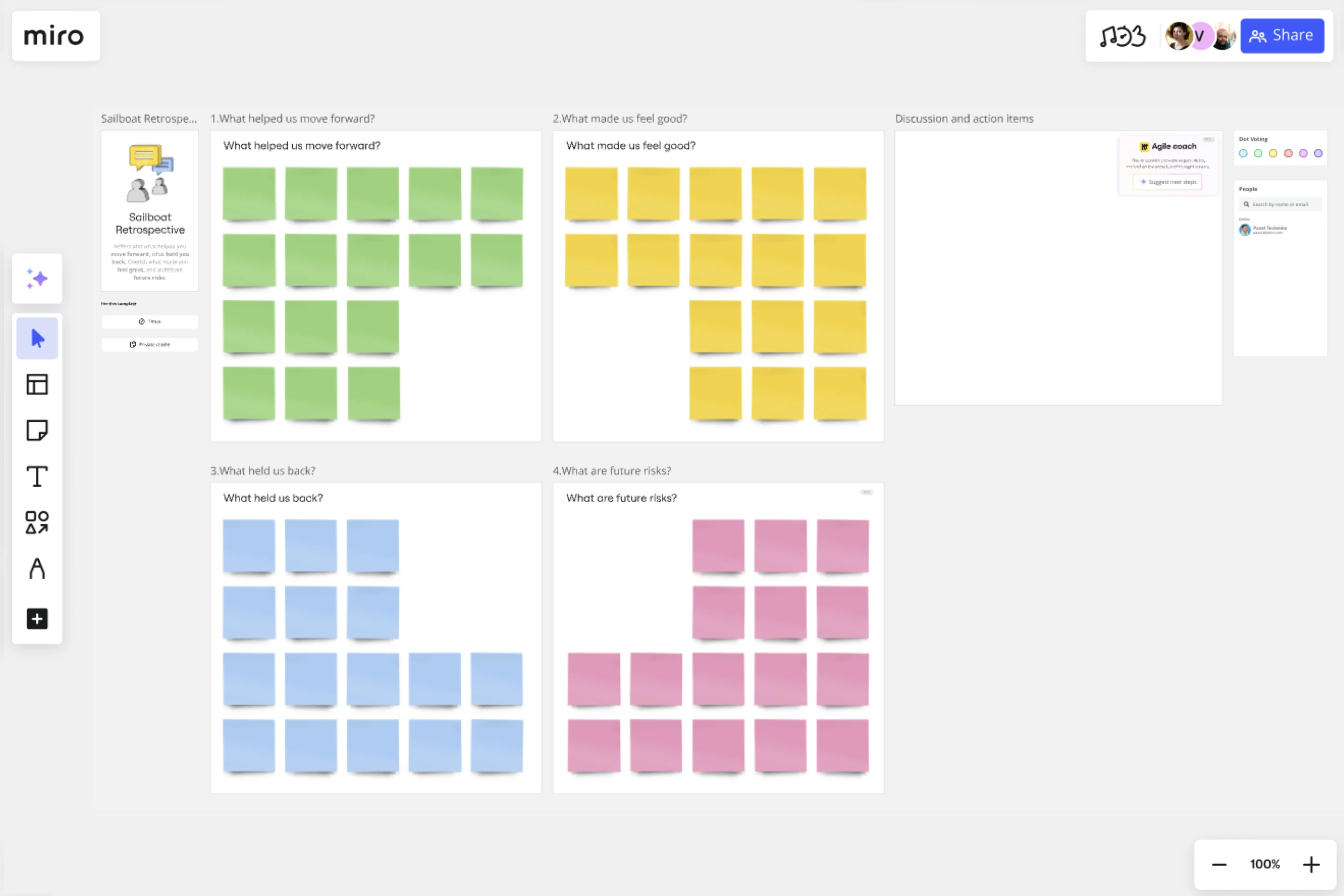
Sailboat Template
Reflect as a team on project goals, blockers, and future ambitions.
About the Sailboat Retrospective Template
The Sailboat Retrospective (also known as the Sailboat Agile Exercise) is a low-pressure way for teams to reflect on how they handled a project. Originally based on the Speedboat retrospective by Luke Hohmann, the exercise centers around a sailboat as a metaphor for the overall project, with various elements broken down:
Rocks - represent risks and potential blockers
Anchors - represent issues slowing down the team
Wind - what helped the team move forward, represents the team’s strengths
Sun - what went well, what made the team feel good
By reflecting on and defining these areas, you’ll be able to work out what you’re doing well and what you need to improve on for the next sprint.
When to use a Sailboat Retrospective Template?
If you are part of an Agile team, you know retrospectives are fundamental to improving your sprint efficiency and getting the best out of your team. The Sailboat Retrospective Template helps you organize this Agile ritual with a sailboat metaphor. Everyone describes where they want to go together by figuring out what slows them down and helps them reach their future goals.
Use this template at the end of your sprint to assess what went well and could have been done better.
Benefits of the Sailboat Retrospective Template
When facilitating your team’s retrospective, this template is an easy way for everyone to jot down ideas in a structured manner. The metaphor of a sailboat gliding over water can help team members think about their work as it relates to the overall course of the project, and the ready-made template makes it easy to fill in and add stickies with ideas and feedback.
To run a successful sailboat retrospective meeting, use Meeting mode to lead your team through each frame, set a timer for each section of the template, and control what participants can do on the board.
Create your own sailboat retrospective
Running your own sailboat retrospective is easy, and Miro’s collaborative workspace is the perfect canvas on which to perform the exercise. Get started by selecting the Sailboat Retrospective Template, then take the following steps to make one of your own.
Introduce the sailboat metaphor to your team . For some teammates, this may be the first time they’ve heard the analogy. Explain the four components, and feel free to frame them as questions (for example, “what helps us work to move forward?”, “what held us back?”, “what risks do you see in our future?”, “what made us feel good?”). Then, tie the visual metaphor back to how to run an Agile sprint. Like a sailboat, a sprint also has factors that slow it down, and risks in the face of a goal, target, or purpose to reach.
Ask each team member to write and reflect individually. Give everyone 10 minutes to create their own sticky notes. Ask them to record their thoughts and reflections relevant to each area of the retrospective. Use Miro’s Countdown Timer to keep things on track.
Present your reflections in pairs or small groups. Spend five minutes each taking turns to dig deeper into the insights recorded on each sticky note.
Choose one team member to group similarly-worded insights together. That team member can spot patterns and relationships between the group’s insights. Accordingly, the team can get a sense of which area had the biggest potential impact on the project.
Vote as a team on what the critical issues are to focus on mitigating and developing. Use the Voting Plugin for Miro to decide what’s worth focusing time and effort on. Each person gets up to 10 votes and can allocate multiple votes to a single issue.
Diagnose issues and develop outcomes. Discuss as a team what your follow-up action plans are for maintaining or building on helpful behavior and resolving issues in preparation for future sprints. Add another frame to your board by clicking Add frame on the left menu bar and annotate your team’s insights and next steps.
Dive even deeper into how to make your own sailboat retrospective – and see examples – in our expert guide to making your own sailboat retrospective .
How do you conduct a sailboat retro?
When conducting a sailboat retro, make a space for you and your team to uncover valuable insights, some of which might not be shareable across your organization. For that reason, make sure to adjust your privacy board settings so that only you and your team can access it, and let them know this is a safe space to share ideas and feedback honestly. The Sailboat Retrospective Template is built for you to run your meeting session smoothly, having complete control of how participants can add to the board. Start explaining the concept of the sailboat retro methodology. If they don’t know it already, guide them through your meeting agenda and set the timer for each section. After the meeting, gather insights in another frame on the same board, and thank everyone for contributing to your retro.
What is the sailboat exercise?
The sailboat exercise is a widely known Agile ritual where you and your team can thoroughly analyze what went well during your last sprint and what could have gone better, so you improve in the next one. This meeting format is similar to a brainstorming session. In each quadrant of the sailboat template, ask your team to add their thoughts and feedback. Use the sailboat exercise when you want to improve processes and gather constructive feedback from your team.
Get started with this template right now.
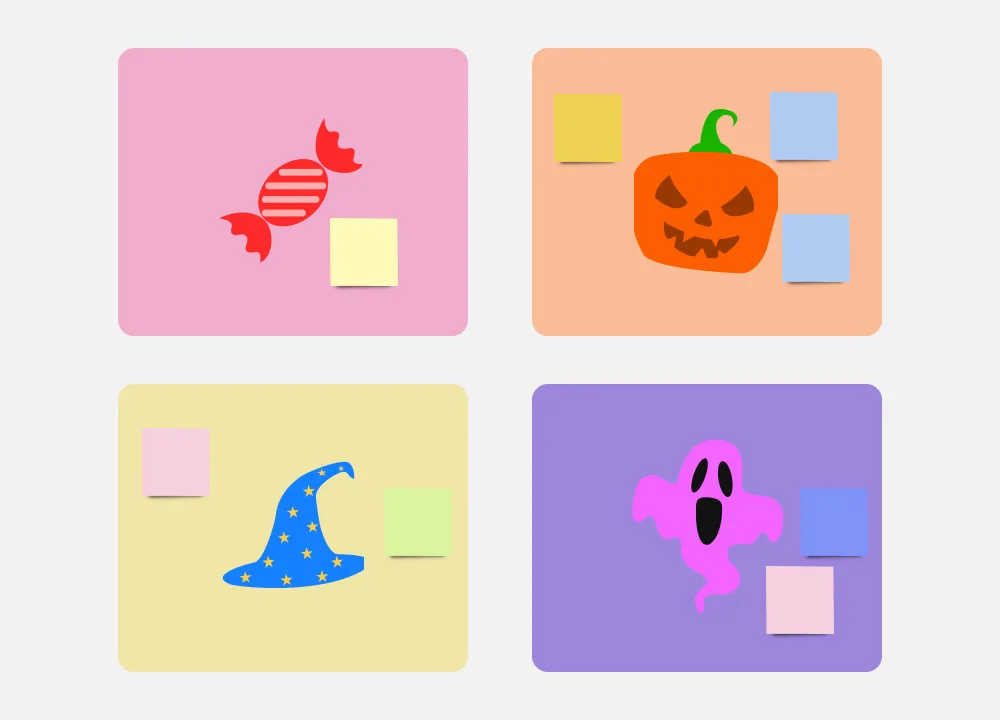
A Halloween Retro
Works best for:.
Retrospectives, Meetings, Agile Methodology
The Retrospective Halloween template offers a themed approach to retrospectives, perfect for the spooky season. It provides elements for reflecting on past iterations, identifying scary issues, and brainstorming solutions. This template enables teams to have fun while addressing serious topics, fostering creativity and collaboration. By promoting a playful yet productive atmosphere, the Retrospective Halloween empowers teams to tackle challenges, drive improvement, and strengthen team cohesion effectively.
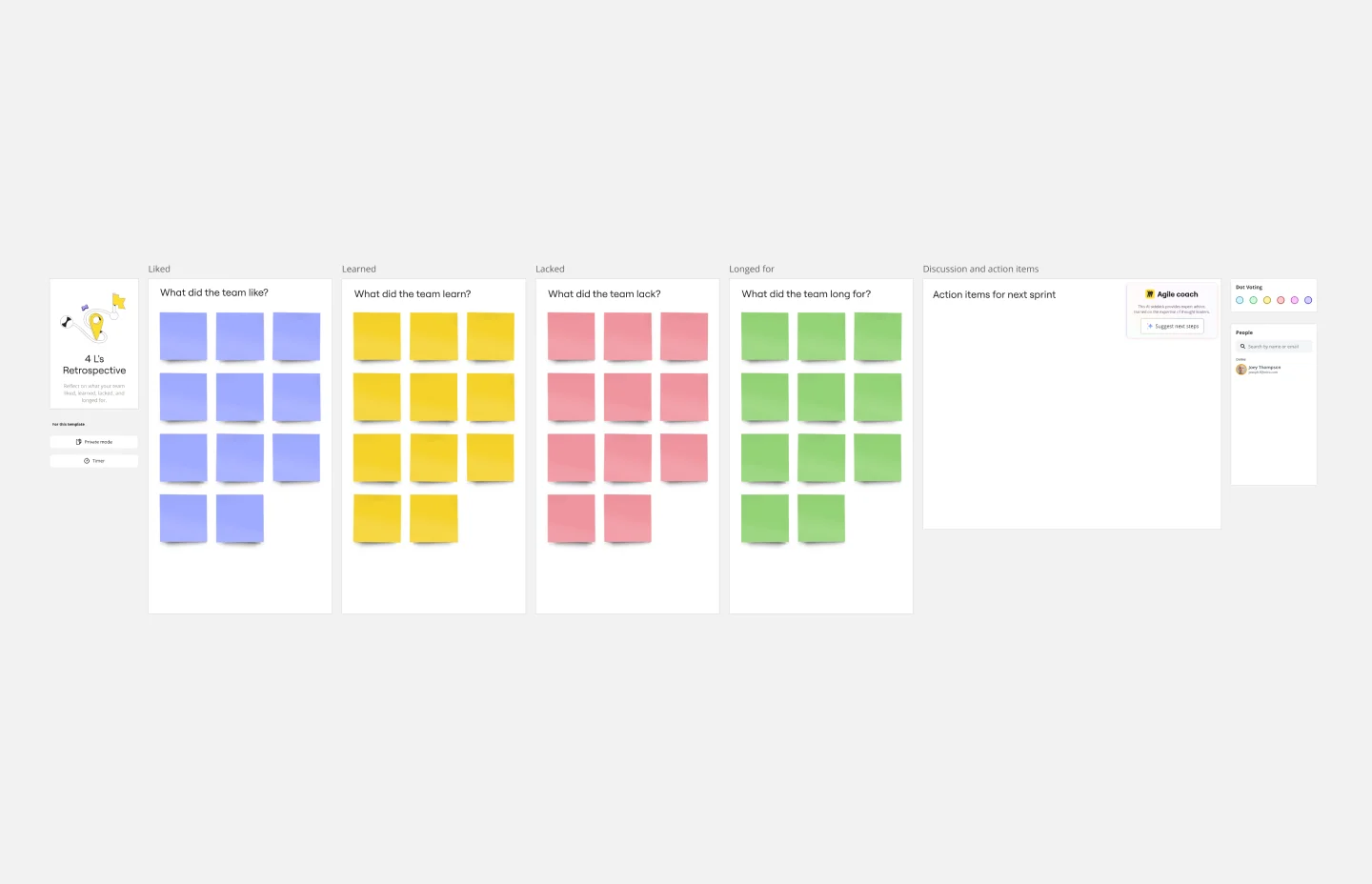
4 L's Retrospective Template
Retrospectives, Decision Making
So you just completed a sprint. Teams busted their humps and emotions ran high. Now take a clear-eyed look back and grade the sprint honestly—what worked, what didn’t, and what can be improved. This approach (4Ls stand for liked, learned, lacked, and longed for) is an invaluable way to remove the emotion and look at the process critically. That’s how you can build trust, improve morale, and increase engagement—as well as make adjustments to be more productive and successful in the future.

Lesson Reflection Template
Education, Meetings
The Lesson Reflection template is a tool to create space for self-reflection and improvement. Students can evaluate the key takeaways from a lesson and what are the topics they find most interesting. As teachers receive the student’s Lesson Reflection, they can look for opportunities to improve learning and teaching methodologies. The Lesson Reflection template can help you facilitate the educational process, and it’s easy to use and straightforward.
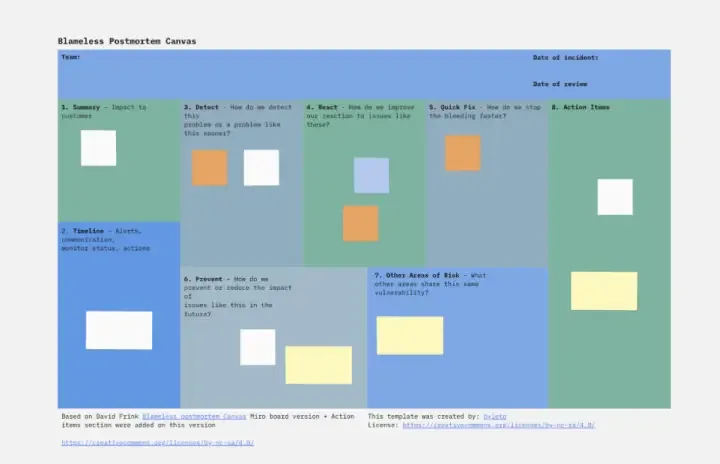
Blameless postmortem canvas
The Blameless Postmortem Canvas is a structured framework for conducting blameless postmortems following incidents or failures. It provides sections for documenting the timeline, impact, root causes, and actionable insights. This template promotes a blame-free culture of learning and improvement, enabling teams to analyze incidents objectively, identify systemic issues, and implement preventive measures. By fostering transparency and accountability, the Blameless Postmortem Canvas empowers organizations to learn from failures and enhance resilience, driving continuous improvement and reliability.
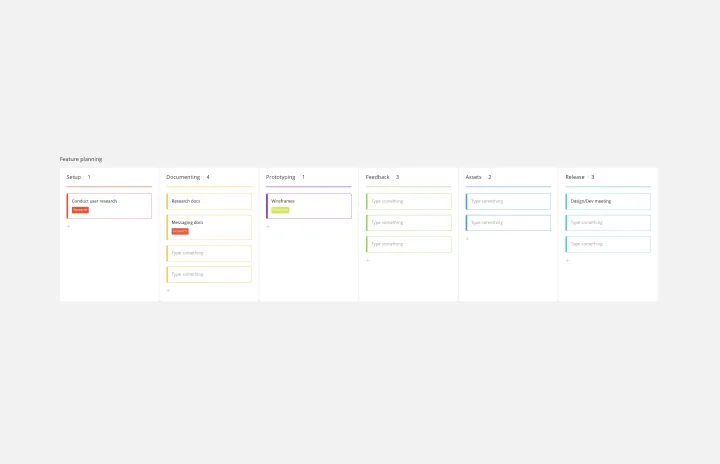
Feature Planning Template
Desk Research, Agile Methodology, Product Management
Features are what make a product or service fun, but adding new ones is no walk in the park. It takes many steps—ideating, designing, refining, building, testing, launching, and promoting—and just as many stakeholders. Feature Planning lets you put a smooth, sturdy process in place, so you can add a feature successfully, and spend less time and resources doing it. That makes our Feature Planning Template a smart starting point for anyone looking to add new product features, especially members of product, engineering, marketing, and sales teams.
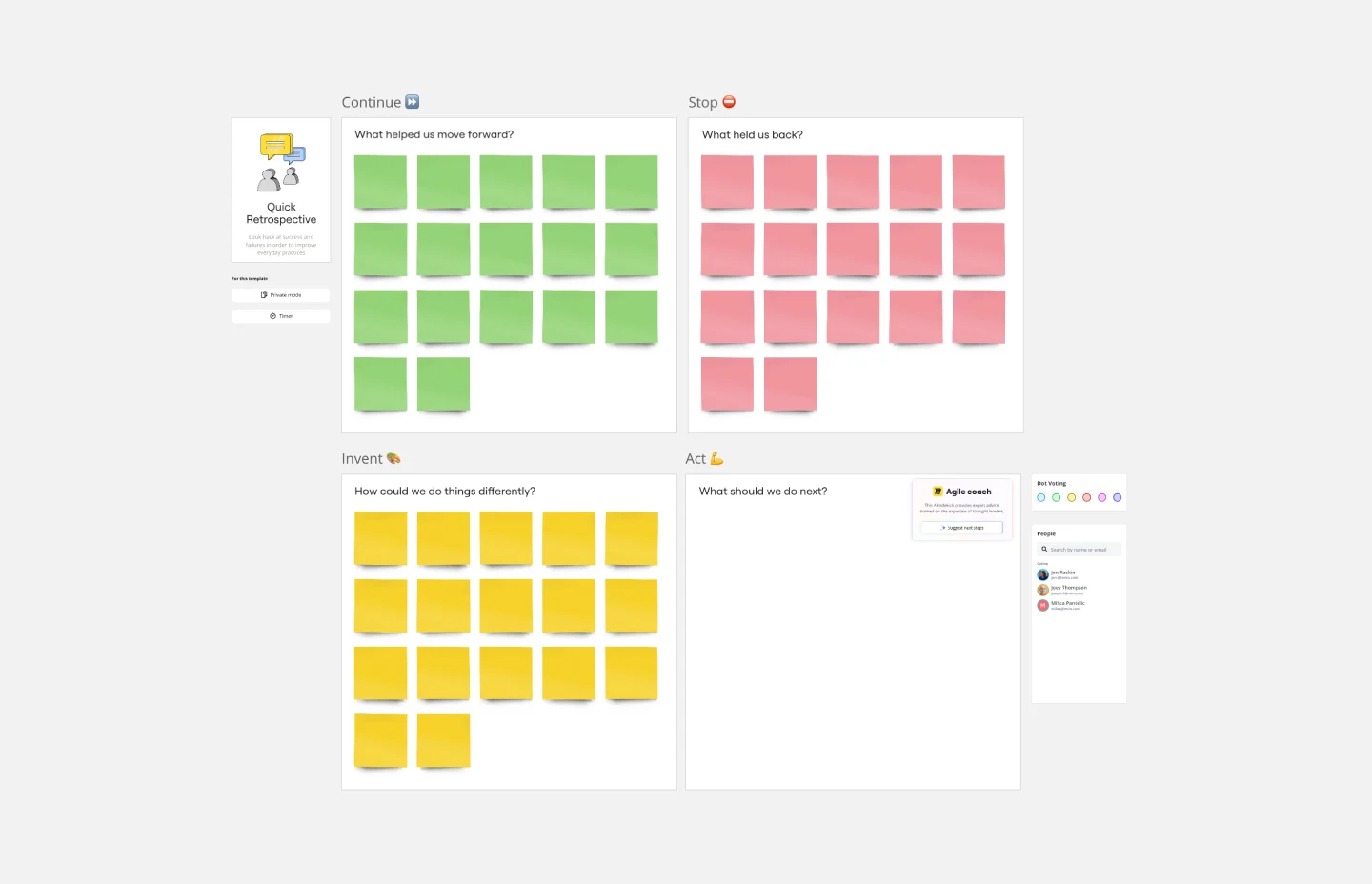
Quick Retrospective Template
Education, Retrospectives, Meetings
A retrospective template empowers you to run insightful meetings, take stock of your work, and iterate effectively. The term “retrospective” has gained popularity over the more common “debriefing” and “post-mortem,” since it’s more value-neutral than the other terms. Some teams refer to these meetings as “sprint retrospectives” or “iteration retrospectives,” “agile retrospectives” or “iteration retrospectives.” Whether you are a scrum team, using the agile methodology, or doing a specific type of retrospective (e.g. a mad, sad, glad retrospective), the goals are generally the same: discovering what went well, identifying the root cause of problems you had, and finding ways to do better in the next iteration.
Sailboating: How This Agile Activity Can Help You Spark Innovation
UI/UX Design

Working Agile
When developing a digital product, the classic process involved documenting requirements, designing solutions, and building and testing in a waterfall approach. Then Agile came around and changed everything, decreasing the time it took to deliver working software and reducing the need for front-loaded documentation.
By working in ‘sprints’, development teams can focus on core requirements to build a product, while allowing for the ups and downs that come with developing complex technology. An added bonus is that clients can deliver feedback after sprints rather than at the end of the ‘completed’ project.
Agile is a system of working, but it’s also a mindset based on promoting better interaction between the people involved in the project, the flexibility to change things when required, and focusing on working, functional product over bureaucracy. It’s a flexible way of working - hence the name ‘agile’, but it also encourages the concept of taking stock after a sprint to see what worked and what didn’t.
This is often called an Agile retrospective. These are exercises performed after a sprint or project to determine efficiency and spot problems or issues so a team can avoid them in the future. It also ties into a Lean methodology in that a retrospective helps cut future waste.
One of the most powerful forms of retrospectives comes in the form of the ‘sailboat exercise’.
What is the Agile Sailboat?
If you’re planning to work in an Agile system, or working with an agency that utilises Agile methodology (hint hint, it’s us), then you’ll probably encounter the term sailboating.
Even if you’re NOT an agile organisation, the sailboating exercise can still be a great way to help rethink your projects and prioritise the production journey. It’s a visual metaphor and an exercise that focuses on the team and future direction.
A sailboat workshop involves two main processes: the team writing down answers to a few questions and then mapping these answers against the ‘sailboat’ metaphor.
You can use a digital board such as Miro for this, or Sticky notes will do the trick if you’re doing it in person. Ask your team the following questions (adjusting based on whether you’re running this as a sprint exercise or at an operational level.)
At operational level:
What’s moving us forward?
What are our goals?
What’s holding us back?
What’s not gone so well?
For sprint exercises:
What risks did the sprint/project face?
What delayed the sprint?
What propelled the sprint forward?

The Sailboat in action at a KOMODO Innovation Workshop.
Once your team have created their answers as Sticky Notes, ask them to stick them to a graphic you’ve drawn or printed that includes the following elements:
A boat - this is your team/project.
An island - this is the goal you’re working towards. It can be the specific features designed in a sprint or a more operational-level goal.
Wind in your sails : what propels your team/project forward.
Rocks : the risks your project faces in the future as it reaches the goal.
Anchor : the problems and challenges which delayed the sprint/project.
Once the team has had a chance to place their sticky notes, go through as a group and see if you agree on the placements. Then see if there’s a common theme being suggested by multiple people as a delay.
Just like you would in an Agile sprint, you can use this information to pivot and enact change. For example, if there’s an anchor problem holding your team back, prioritise a way to remove it. Outlining the ‘rock’ or future risk also helps you spot potential obstacles that should be dealt with before they become a problem and ‘sink’ the ship.
The sailboat exercise is great because it’s a visual metaphor that is easy to understand. It aligns the team and quite literally puts everyone in the same boat. For an agency/client relationship, sailboating also helps both sides of the relationship feel they are aligned and heading in the right direction.
While the Sailboat method is so often used in a retrospective fashion, we believe it has great value as an onboarding process for new projects and why it features as the first activity in our innovation workshop process.
Sailboat as a prospective tool
The sailboat system can also be used at the beginning of a project to help map out your strengths and weaknesses.
Demand for your product.
What your user’s needs are.
What solutions are most important in terms of priority.
We’ve written about this sort of thinking many times - but it’s so important we thought we’d mention it again here in the context of the Sailboat exercise. You can’t, for example, just go into a planning session with ‘general ideas’ of what your customers want. Instead, you need to do research and ensure that your product can solve a genuine need . Otherwise, it’s all based on guesswork.

Once you know enough about your users, you can use Sailboat to plan the overall product or project. This time, you’d define the elements as:
Rocks : what risks does the product face in terms of competitors, technical issues, user error?
Island : what functional requirements are most important - they should be positioned closer to the ‘shore’ to create priorities.
Anchor : what issues could delay the project. Think of factors like stakeholder intervention, poor client/agency communication etc.
Wind/sail: what can contribute towards the product being completed to the right timeframe?
While you might not have the same retrospective analysis to assign actual, tangible things that went wrong for your rocks etc. The sailboat is still a good way to map out a project at the beginning to get your team on the same page.
Remember that the sailboat as a concept is not really that important. It could be many different visual metaphors - all of them just have to share a way to map goals, threats and success factors.
By completing these exercises either at the start of a project or as a retroactive after a sprint as intended, you’ll be putting your team on the right track and creating a more collaborative process both internally and, if working with an agency, externally too.
The sailboat is just one Agile exercise we love. If you choose to work with KOMODO for your digital product development, we’ll lend our workshopping expertise to your project journey to help ensure the product is as functional and successful as it can be. Get in touch if you’d like to know more .
Got an idea? Let us know.
Discover how Komodo Digital can turn your concept into reality. Contact us today to explore the possibilities and unleash the potential of your idea.
Get in touch
Sign up to our newsletter
Be the first to hear about our events, industry insights and what’s going on at Komodo. We promise we’ll respect your inbox and only send you stuff we’d actually read ourselves.
Latest articles

Life at Komodo
Komodo Digital Hosts Buzzing FinTech Social in Partnership with FinTech North

A Complete Guide to Creating a Design System That Works in 2024

Web Development
9 Reasons Why React is Still Popular in 2024
Some of our case studies.

A Robust Data-Heavy Platform For Just-In-Time Print Logistics

Building with Nature
Agile software development for cutting-edge lawtech startup.

App Development
Cross-Platform Mobile App for Gathering Clinical Trials Feedback

Facilitation
Hire me to facilitate your retrospective or a custom made workshop!
Book me now!
How to Run a Sailboat Retrospective: A Step-by-Step Guide
Explainer video
Introduction
The power of the sailboat retrospective is in the way you visualize everything from the previous sprint. You can visualize the sprint goal on the template as your focus point.
Running the sailboat retrospective, you and your team are trying to find how to get the boat to smooth sailing. Searching for risks they'll face, seeing what is working, looking for things that are slowing them down, and making sure the sailboat is heading in the right direction.
The sailboat retrospective template is one of the top agile retrospectives you can use to improve your team!
The elements of the sailboat retrospective
The retrospective consists of five elements. The sailboat, the sail, the anchor, the rocks, and the island (the focus point of the retrospective).
It gives you, as the facilitator, the perfect starting point to communicate the exercise through metaphors.

The sailboat
The sailboat represents the entire team and their processes sailing to their goal. You can use the metaphor: "Is the sailboat heading in the right direction?"
The island represents the sprint goal of your team's last sprint. This is where the team wants to go.
What is giving us wind in our sails to go to the island? What helps us move forward?
The team focuses on the good things that are happening and are helping them achieve their goals. What efforts move the team forward to their sprint goal?
What is holding us back from going to the island?
Here the team focuses on the bad things that they are doing. They'll look for impediments and issues they've faced.
What are the rocks we face when going to our island?
The rocks represent the potential risks they'll face. This part of the exercise helps them to be proactive about oncoming risks.
The benefits of the sailboat excercise
The sailboat retrospective is a great tool to see if the team is doing the right things to hit their goal. They identify risks, see what is holding them back and get to know what is working.
It brings the team members on the same page and helps improve the team's success. It gives the scrum master valuable feedback that he or she can use to help the teams focus.
As with every retrospective , it helps the team apply continuous improvement in their workflow as described in the agile manifesto .
How to run the sailboat retrospective
Facilitating sailboat retrospectives is pretty straightforward. Every good retrospective has a chronological number of exercises. This format makes it easier for the facilitator and the agile team.
We are going over the sailboat retrospective template, and I'll give you some retrospective techniques where you and your team can focus when creating actionable items.
Set ground rules for the retrospective (+- 3 min)
During a retrospective, we take our team and ourselves under the microscope. This can be an uncomfortable experience for many of us. Therefore we need to set some ground rules with the team and create an atmosphere where people feel comfortable participating.
Good ground rules
- What is said in the retrospective stays between the participants
- It is encouraged to air dirty laundry and express opinions.
- Try to focus on organizational systems and process improvements.
- It is a blame-free environment
- Encourage participation from everyone
Introduce the sailboat exercise (+- 3 min)
When the ground rules are set, we can introduce our sailboat and what we'll do during the retrospective.
Here's an example introduction:
Team, today we are doing the sailboat retrospective. We, the team are on the sailboat. We're trying to go to the island which represents our last sprint goal. [Insert sprint goal]. During our trip we've been lucky to have great wind in our sails. But we noticed that our anchor has been dragging along and slowing us down. We're going to try to raise our anchor a bit higher so we can move faster to our island. Like every sail trip, we'll face some rock along the way. This is risky business. We'll try to inspect what is risks we'll likely face so we can improve our sailboat and go smooth sailing.

The sail (+- 10 min)
The first step the team members take is the sail. Here we are going over what is working for the team. This exercise helps the team loosen up for the harder parts of the sailboat retrospective.
One retrospective technique we'll use throughout is working together alone. This means the exercises are done in silence alone. After a set period, we'll present our ideas and choose one to continue with.
Before flying straight into the sail exercise, introduce it to your team.
The first part of the sailboat retrospective is the sail. We will look what helps us move forward in our journey to our island. [Insert sprint goal] We are going to all work in silence for [Insert forseen time] when we are writing down our thoughts. Write every thought down on individual sticky notes. Afterwards we'll present our sticky notes to each other. Are there any questions?
When time passed that the team worked alone, we'll present the sticky notes to each other and put them on the sail. Keep the presentation simple, don't go deeper into the topic that is written down. Just saying out loud what is written on the sticky note is enough.
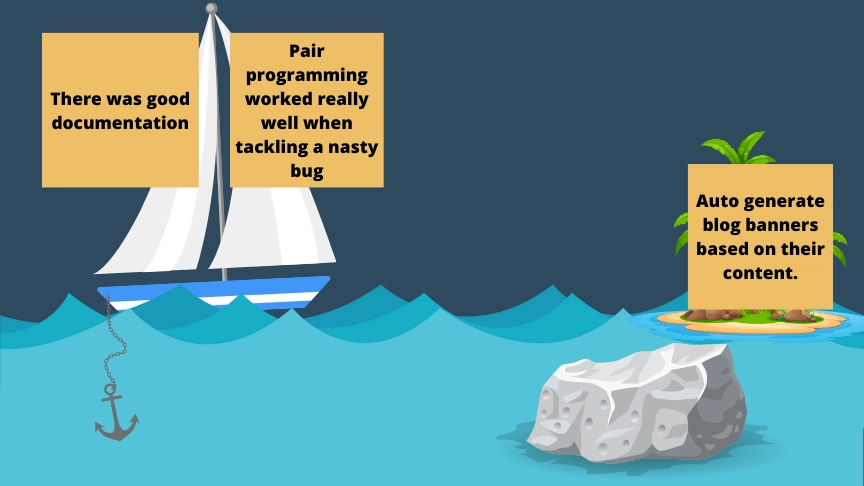
The anchor (+- 10 min)
The second step in the sailboat retrospective is the anchor. Here the team will focus on what is holding them back from reaching their target. Here we are trying to find where our process is lacking.
Here we'll use the same retrospective technique working together alone.
You can use the following template when introducing the anchor to your team.
Now that we know what helps gives us wind in the sails and helps us move forward. We'll now focus on our anchor. What is holding us back for moving forward towards [Insert sprint goal]. We are going to work again in silence alone for [Insert forseen time]. Afterwards we are not going to present the items to each other. We're just going to stick them on the lower side of the sailboat. Are there any questions?
When the time has passed, let the team put the sticky notes on the bottom side of the sailboat.
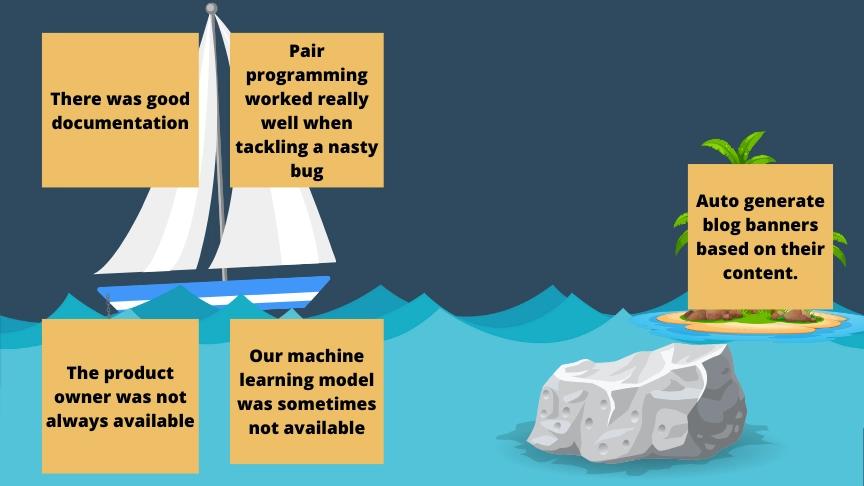
The rocks (+-10 min)
The third step in the retrospective meeting is the rocks. What rocks lie ahead of the team? After this exercise, we'll have identified risks we can be proactive about.
Again, we're working together alone. Afterward, we can stick our sticky notes on the rocks below our boat.
Here's an example introduction to the rocks:
Now that you've written down our anchors for our team, we're going to look ahead and see what risks we face for reaching [Insert sprint goal]. Again, we're woriking in silence for [Insert forseen time]. Afterward, we'll stick our sticky notes on the rocks. Are there any questions?
When the time has passed, let the team put the sticky notes on the rocks.
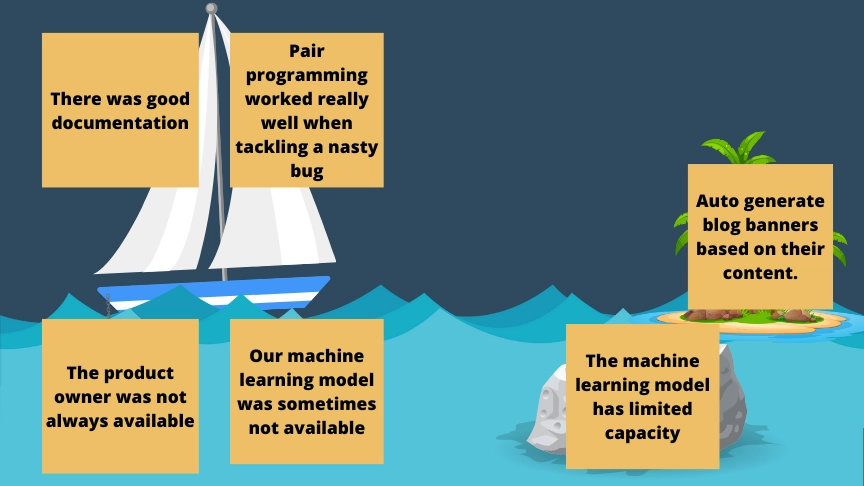
Vote! (+- 10 min)
We've captured a lot of insights from our team. But where do we need to put our focus? This is where we're going to vote.
There are multiple ways to vote for a focus point with your team. Here we are going to use dot-voting .
Give each team member ten votes they can use to vote on the sticky notes. They can vote on their own post-its and vote multiple times on one post-it. There are no rules.
While the team is voting, they can rearrange the post-its to make groups of related items.
Here is an example introduction to the voting part of the retrospective:
Now that we've capture all of our insights it is time to choose where we want to focus on as a team. We'll do this with our voting dots. You can vote on your own items and vote on multiple times on one item. While we are looking over our insights, rearrange the items to group them toghether if they are related. Are there any questions?
After time has passed, take the item with the most votes and put them to the side of the sailboat. Continue this step until you've created a top 3.
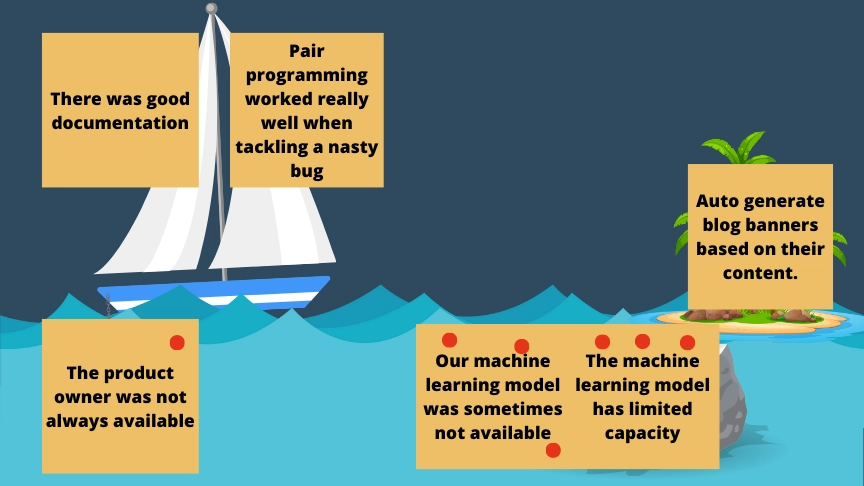
Brainstorming session ( +- 15 min)
We now know where the team wants to focus its efforts toward improving its processes. Now it's time to brainstorm ideas to improve future sprints.
We take the most voted issue and rephrase it to an opportunity question. We use the "How Might We" structure to create an opportunity for our anchor or risk that has been chosen.
Take the "How Might We" question you've created and put it on the top of another whiteboard or flipchart.
While we are brainstorming, everyone should work in silence again.
Here is how I would introduce the brainstorming session:
It is clear for us as a team where we want to put our efforts to improve our processes. We are going to brainstorm on [Insert "How Might We" question]. You get [Insert forseen brainstorm time] to generate ideas that we can do in the next sprint to resolve [Insert problem statement]. You are working in silence again.
When the timer goes off, the team must select the best ideas. Here you can give them five votes to vote on the best ideas.
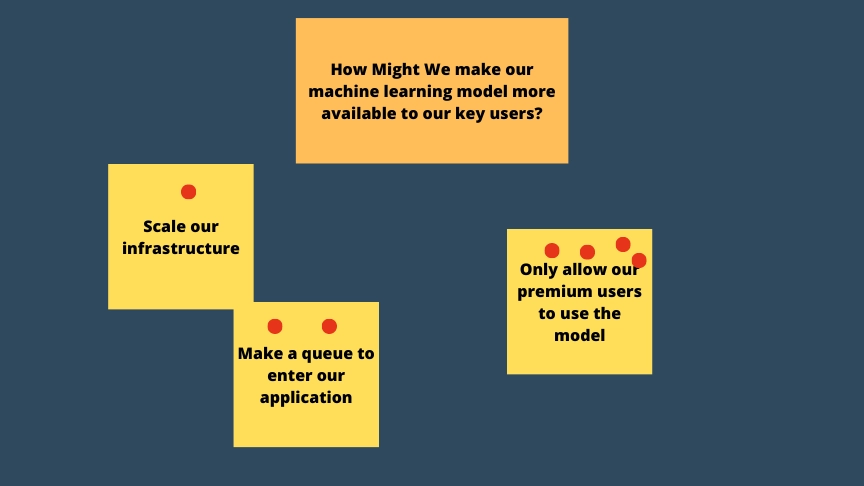
Create actionable items (+- 10 min)
The team voted on the best idea they've found. Now it is time to take action! An idea is great, but execution is needed to improve their current process.
For an agile team, this could mean updating their definition of done. Most of the time, you'll define an experiment you'll run with the team.
- When writing an experiment, consider the following questions.
- How long will this experiment run?
- Who is going to conduct this experiment?
- What is the expected outcome of this experiment?
- When are we going to reflect on this experiment?
You can write your experiment in the following format:
What? Only allow our premium users to use the model. Who? Team Zebra When? Next sprint Expected outcome? Our premium users use the machine learning model more. Reflection date? 20/04/2023
The sailboat retrospective is a great tool to create team alignment for improving the team processes. The metaphorical way helps the facilitator and the team in the process to identify areas where they can improve, what is holding them back, and the risks they'll face.
You might also like
Professional Workshop Facilitation
Having a hard time making decisions? Having a workshop coming up? Hire me to organise, create and facilitate your custom made workshop!

IMAGES
VIDEO
COMMENTS
Discover how to run a Sailboat workshop to find out what your goals are, and what’s stopping you from achieving them. This workshop tactic brings together teams and stakeholders to gain a shared understanding of their goals, drivers and barriers.
The sailboat retrospective is a retrospective technique where you and your agile team members will envision the last sprint as a sailboat. It’s a visual way for your team to identify what pushed the project forward, as well as what held it back.
The Sailboat Exercise is an interactive brainstorming process (and neat visual tool) for garnering honest feedback from employees about the state of the team / product / company during team retreats.
The Sailboat Retrospective is a technique that will help your team easily visualize a sprint’s obstacles, risks, and ultimate goals. Here’s how to run one.
Sketch a sailboat or use a digital template. Draw a Sailboat sailing in the sea (your team or project) and an Island (the final destination, goal, or vision) and two or more of the following symbols: The sun – good things that can come out of this.
This post explains how to use the SailBoat Retrospective or sometimes called Sailboat Exercise. This technique is extremely simple but powerful.
The Sailboat or Speedboat Method for Sprint Retrospectives is an easy way to: adopt, reflect and map the team’s way forward easily, in a fun, tactile and visual way. It helps the team to reflect on what’s going well and what could be better, analyze their sails and anchors and identify opportunities for improvement or change.
Use our free Sailboat Retrospective Template and help your team reflect on project goals, blockers, and future ambitions. Improve efficiency and gather valuable insights with this agile ritual.
A sailboat workshop involves two main processes: the team writing down answers to a few questions and then mapping these answers against the ‘sailboat’ metaphor’. You can use a digital board such as Miro for this, or Sticky notes will do the trick if you’re doing it in person.
Discover how to run a sailboat retrospective (with facilitator notes) and the techniques you and your team can use to focus on creating actionable items. Get valuable feedback and apply continuous improvement to your workflow with the help of the sailboat retrospective.